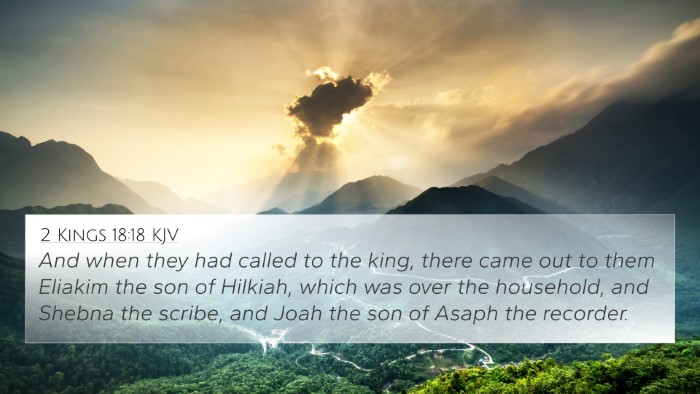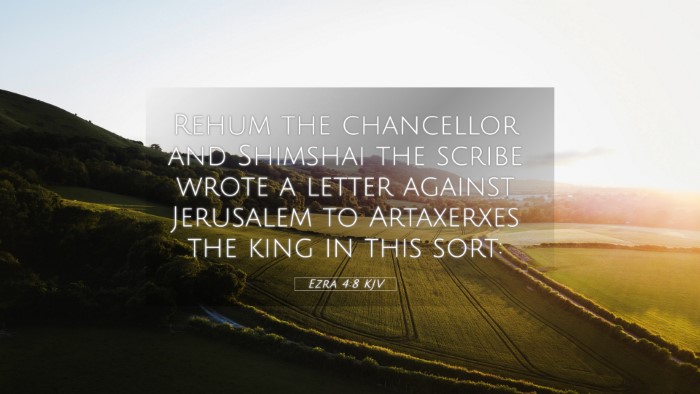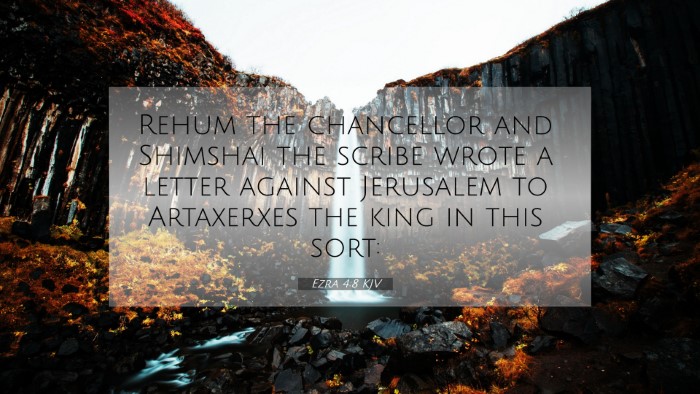Old Testament
Genesis Exodus Leviticus Numbers Deuteronomy Joshua Judges Ruth 1 Samuel 2 Samuel 1 Kings 2 Kings 1 Chronicles 2 Chronicles Ezra Nehemiah Esther Job Psalms Proverbs Ecclesiastes Song of Solomon Isaiah Jeremiah Lamentations Ezekiel Daniel Hosea Joel Amos Obadiah Jonah Micah Nahum Habakkuk Zephaniah Haggai Zechariah MalachiEzra 4:8 Similar Verses
Ezra 4:8 Cross References
Rehum the chancellor and Shimshai the scribe wrote a letter against Jerusalem to Artaxerxes the king in this sort:
Uncover the Rich Themes and Topics of This Bible Verse
Listed below are the Bible themes associated with Ezra 4:8. We invite you to explore each theme to gain deeper insights into the Scriptures.
Ezra 4:8 Cross Reference Verses
This section features a detailed cross-reference designed to enrich your understanding of the Scriptures. Below, you will find carefully selected verses that echo the themes and teachings related to Ezra 4:8 KJV. Click on any image to explore detailed analyses of related Bible verses and uncover deeper theological insights.

Ezra 4:9 (KJV) »
Then wrote Rehum the chancellor, and Shimshai the scribe, and the rest of their companions; the Dinaites, the Apharsathchites, the Tarpelites, the Apharsites, the Archevites, the Babylonians, the Susanchites, the Dehavites, and the Elamites,

2 Samuel 8:17 (KJV) »
And Zadok the son of Ahitub, and Ahimelech the son of Abiathar, were the priests; and Seraiah was the scribe;

2 Kings 18:18 (KJV) »
And when they had called to the king, there came out to them Eliakim the son of Hilkiah, which was over the household, and Shebna the scribe, and Joah the son of Asaph the recorder.
Ezra 4:8 Verse Analysis and Similar Verses
Understanding Ezra 4:8
Ezra 4:8 reads: "Rehum the chief deputy, and Shimshai the scribe, wrote a letter against Jerusalem to Artaxerxes the king in this sort:" This verse introduces us to the opposition faced by the Jewish people as they sought to rebuild Jerusalem after the Babylonian exile. Understanding this verse requires contextualizing it within the larger narrative of Ezra and the historical backdrop of the Jewish return to their homeland.
Contextual Background
The book of Ezra details the return of the Israelites from Babylonian captivity and their efforts to restore worship in Jerusalem. After the initial enthusiasm of Zerubbabel and Jeshua, there arose opposition from the surrounding people, which culminates in the letter mentioned in Ezra 4:8.
Commentary Insights
- Matthew Henry's Commentary: Henry notes that Rehum and Shimshai represent the adversaries of the Jews, whose aim was to halt the rebuilding efforts. Their letter to Artaxerxes seeks to describe the Jews as rebellious and a threat to the empire, highlighting the political gamesmanship of the time. This illustrates the challenges faced by those seeking to follow God's commands in the face of worldly opposition.
- Albert Barnes' Commentary: Barnes emphasizes the significance of this letter in the broader context of Jewish history. The accusations within the letter reveal the tension between different peoples and the struggle of the Jews to assert their national identity amidst foreign powers. This serves as a reminder of the persistent struggles faced by the faithful in a secular world.
- Adam Clarke's Commentary: Clarke focuses on the strategic nature of the communication, which was intended to sow distrust between the Jewish community and the Persian authorities. He indicates that the letter represents a common tactic in maintaining control over subjugated peoples, highlighting a theme of manipulation in power dynamics.
Bible Verse Cross-References
To deepen the understanding of Ezra 4:8, consider the following cross-references that reveal connections between different scriptures and expand on the theme of opposition and restoration:
- Nehemiah 2:10: Discusses the adversaries of the Israelites, specifically Sanballat and Tobiah, who were displeased by the news of Jerusalem's reconstruction.
- Isaiah 54:17: States that no weapon formed against the Israelites shall prosper, affirming God's protection amidst opposition.
- Acts 4:26-28: Highlights the collective opposition against God's anointed ones, providing parallels to the resistance faced in Ezra.
- Zachariah 1:16: Where God promises to return to Jerusalem, emphasizing restoration despite the struggles with external oppressors.
- Matthew 10:16: Jesus warns His followers of the adversarial conditions they will face, echoing the challenges found in Ezra.
- Psalm 2:1-3: A poetic reflection on why the nations rage and plot in vain against the Lord and His anointed.
- 2 Chronicles 36:23: Where King Cyrus issues a decree for the rebuilding of the temple, signifying God’s sovereign plans despite opposition.
Thematic Bible Verse Connections
Ezra 4:8 not only brings forth the theme of opposition but also highlights several theological and historical connections.
- Opposition to God’s Work: Similar to how the Jews faced opposition when rebuilding the temple, Christians today may encounter resistance when advancing God's work.
- God’s Sovereignty in History: Across the scriptures, we see God using leaders like Artaxerxes, as well as enemies, to accomplish His divine purposes.
- The Resilience of Faith: The faith of the Jews in rebuilding Jerusalem, similar to Paul in his epistles, serves as an encouragement for believers to persevere amidst adversity.
Application
Understanding Ezra 4:8 and its implications helps modern believers recognize the realities of spiritual warfare and the importance of remaining steadfast in faith:
- Recognizing that opposition may come unexpectedly, believers must prepare their hearts and minds for challenges.
- The significance of unity among God’s people to overcome adversity, as demonstrated by the Jews in rebuilding efforts.
- Trust in God's promises and His ultimate control over all situations, reassuring believers in their endeavors.
Using Cross-References in Bible Study
To effectively study verses like Ezra 4:8, here are some tools for Bible cross-referencing:
- Bible Concordance: Use a concordance to find related verses and terms.
- Bible Cross-Reference Guide: Explore guides that suggest related scripts based on themes.
- Cross-Referencing Bible Study Methods: Adopt various methods like thematic studies, parallel readings, or historical context explorations.
- Bible Reference Resources: Access resources that compile cross-references for comprehensive studies.
Conclusion
Ezra 4:8 serves as a poignant reminder of the opposition faced by the faithful in the context of rebuilding and restoration. By seeking a deeper understanding through cross-references and commentaries, believers can find hope and encouragement amid adversity, knowing they are part of an ongoing story of God's faithfulness.



